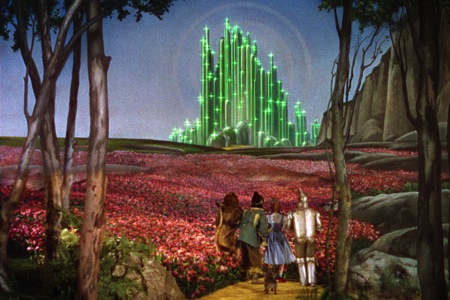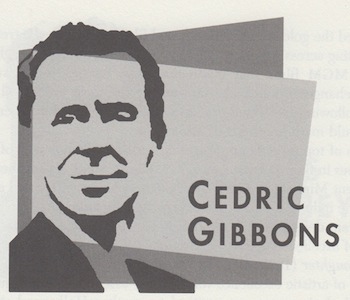Born: March 23, 1893, New York, NY
Died: July 26, 1960, Westwood, CA
MGM was not run, oddly, by L.B. Mayer, but by the head of the art department.
—Elia Kazan
Cedric Gibbons was appointed head of the art department at the newly formed MGM in 1924, following short stints with the Thomas Edison studio and the independent Goldwyn company. While negotiating his contract, he had a clause inserted that stated his name was to be listed as art director on every MGM film during his tenure. This gave Gibbons’s name the greatest exposure on screens for thirty-two years, and to this day he has accumulated more credits than any other single person in film history; listed on more than fifteen hundred films as “art director,” Gibbons worked on only a handful. But if Gibbons was not “the” art director on every film, he was the key architect of the glitzy look that shimmered across nearly all MGM films.
The son of two architects, Gibbons was born to high style. He was a vain man who loved to have his photograph taken, especially since he was seen wearing the latest fashions. He lived a life filled with expensive cars, beautiful wives and exotic food. His personal fashion sense inspired those around him, and even costume designers sought his advice.
As the head of a collective of studio art directors and set designers, Gibbons introduced three-dimensional furnishings to replace the flat, painted backdrops of previous films. His characteristic flair and his art deco-style sets distinguished the golden era of Hollywood films and sparked a trend in interior decorating across America. Gibbons is also responsible for lighting innovations in MGM films that made the other studios follow suit. These significant changes would make him one of the most influential figures in the years following the sound era, and Gibbons’s talent for supervision and training would mark hundreds of MGM films.
His team of top production designers reads like a who’s who of important design figures in film: Preston Ames, Jack Martin Smith, Lyle Wheeler, Raoul Dufy, Vincent Minnelli and William Cameron Menzies. He had available to him all of the industry’s top special effects men, including A. Arnold Gillespie. The consistent design work of Gibbons’s team easily passed Irving Thalberg’s standards of excellence in The Big Parade (1925) and was prominent in Our Dancing Daughter (1928) and The Bridge of San Luis Rey (1929). His personal sense of artistic excellence was the very essence of MGM quality.
Gibbons’s design sense was critical to another Hollywood standard: in 1927, he was asked by Louis B. Mayer to design a statuette that was to be awarded to selected artists by the newly formed Academy of Motion Picture Arts and Sciences. The famous sculpture took shape as a man holding a sword by the hilt and standing on a film canister. It became known as the “Oscar” several years later; there is some mystery as to the nickname’s origin. Gibbons’s artists were eventually nominated for thirty-seven of the awards, winning eleven, one for a film that Gibbons designed alone.
Though indoor sets most exemplify his influence, Gibbons also worked on adventure films, including Ben-Hur (1926), Mutiny on the Bounty (1935) and Captains Courageous (1937). Gibbons himself directed only one film, Tarzan and His Mate (1934), and the highly praised visuals spawned a popular series. Given Gibbons’s guidance, the MGM musicals and comedies of the thirties and forties stayed on top: Grand Hotel (1932), The Thin Man (1934), A Night at the Opera (1935) and Ninotchka (1939) remain best of their respective classes.
The Wizard of Oz (1939) represented the apogee of Gibbons’s career. He adopted Natalie Kalmus’s Technicolor processes for the film, which is rivaled by only Gone with the Wind of the same year for beauty. But his personal stamp was present on hundreds of films, passed along by a team of designers that carried out his exacting standards. In later years, Gibbons would be nothing more than a figurehead, but his regal taste lingered throughout MGM’s lengthy heyday, and his work still serves as a reference of high style in set design among Hollywood’s finest production specialists.
To read all the republished articles from ‘The Film 100,’ go to Reintroducing the Film 100 here on Keyframe.





